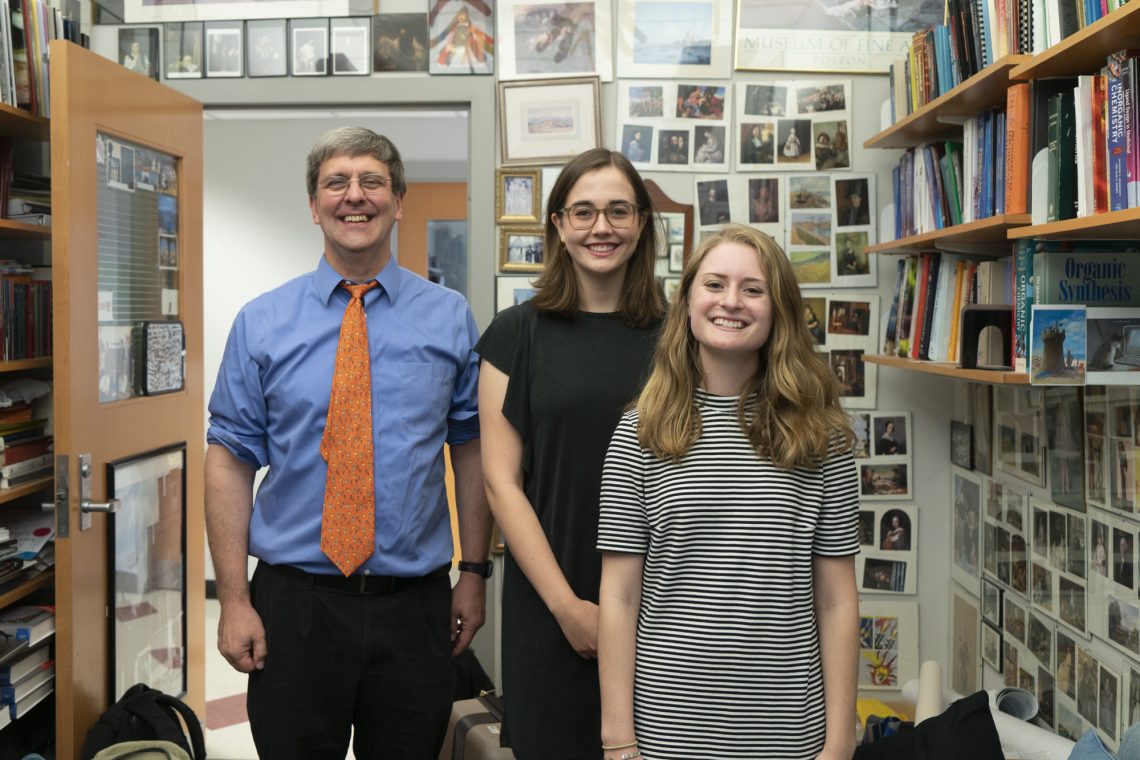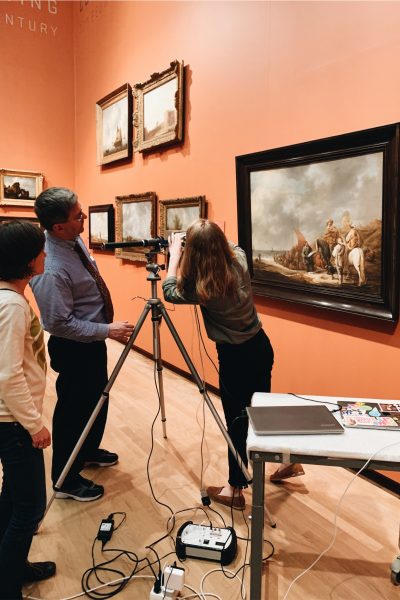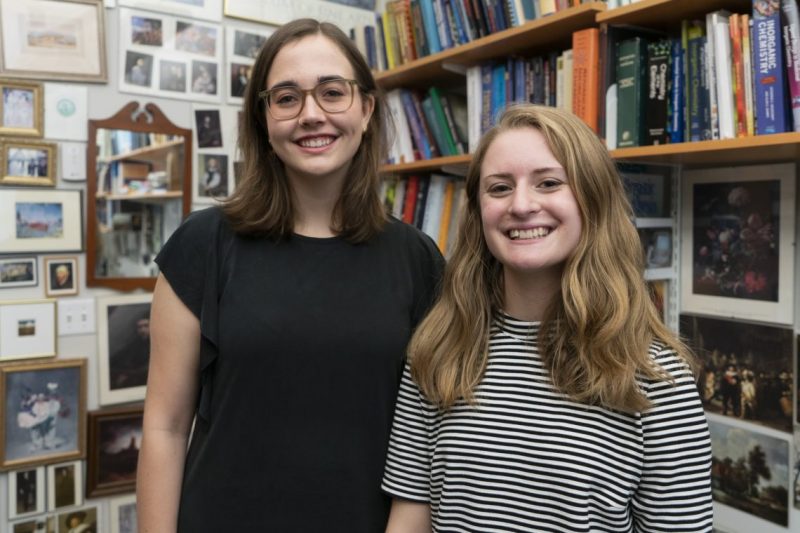
Getting Their Start in Art For Darcy Olmstead '21 and Lindsey Hewitt '21, analyzing art in the Netherlands and the U.S. with Professor Erich Uffelman has been an educational 'dream come true.'
“I am endlessly thankful to Dr. Uffelman for extending such an invaluable opportunity to me, and I genuinely think that opportunities like this make W&L the unique school that it is.”
~ Lindsey Hewitt ’21
Darcy Olmstead ’21 of Fayetteville, Arkansas, and Lindsey Hewitt ’21 of DuBois, Pennsylvania, are both art history majors pursuing minors in cultural heritage and museum studies. They’re spending the summer assisting Bentley Professor of Chemistry Erich Uffelman with analysis of art objects at museums and conservation studios in Europe and America. When they weren’t jetting off to an interesting locale, they took some time to answer questions about the research, their career goals and their close working relationship with Uffelman, who has become a mentor to them.
What are you up to this summer?
Darcy: I’m working as a research assistant under Professor Erich Uffelman in the Chemistry Department. This summer we’re using imaging equipment to assist various art museums with object analysis. We had the opportunity to spend half of our research time in the Netherlands assisting conservators at the Mauritshuis, Frans Hals Museum, SRAL Maastricht, and the Dordrechts Museum. We also went to Luxembourg on a brief stint to assist W&L art history professor Dr. George Bent at the MNHA Luxembourg. We’ll also be working out of Lexington for the rest of the summer, with visits to Winterthur, the Freer Sackler Gallery in D.C., and the North Carolina Museum of Art.
Lindsey: This work allows us, as well as the museums, to gain a deeper understanding of the objects’ histories, the artists and the artists’ processes.
What, specifically, is your role in these projects?
Darcy: My partner Lindsey Hewitt and I are research assistants. This means we assemble and disassemble the equipment, lug it from country to country, and work up all of the data we collect.
Lindsey: We are specifically trained in fiber optic reflectance spectroscopy, portable X-ray fluorescence, hyperspectral imaging and multispectral imaging. We are able to collect, process, and analyze the data from each of the instruments.
How have coursework and previous research experiences at W&L prepared you for this work?
Darcy: I’m an art history major and a museum studies minor (also pursuing a minor in Latin American and Caribbean Studies) so I’ve already spent a lot of my time at W&L talking about art. Yet my fascination with art and art history has always been grounded in the museum world. I grew up going to museums with my family and have always been obsessed with art as a means for public education. I knew before coming to W&L that I wanted to focus most of my art history studies on museums. I was aware of Dr. Uffelman’s Spring Term class on art conservation and planned to take it my first year. The course opened my eyes to a vital part of the museum world that I had previously known so little about.
During Winter Term, we had to take a prerequisite course that introduced us to the basic chemistry behind common art conservation and imaging techniques. Then, that spring, we were able to visit around 20 museums in the Netherlands with some of the best conservation studios in the world. Much of our Spring Term class time was spent discussing the things we saw, and I found myself often swaying the conversation towards the role of the museum. It was these discussions that made me realize how crucial it is for any museum professional or art historian to truly understand the role of conservators. Whether I become a curator or a museum educator, I will have to work alongside conservators. Without them, art history, museums, the art itself — everything I hold dear — would have no validity or hope for surviving. It’s dramatic, but true.
This Winter Term, I began doing research with Dr. Uffelman twice a week. This was the first time I was actually able to use the equipment we had been talking about in the Spring Term class. It was also my first time being inches away from a centuries-old painting. We also worked in our first conservation studios over February break when we drove up to Winterthur in Delaware and the Walters Museum in Baltimore. This helped us fully get into the routine of packing equipment, transporting it and using it in a professional setting.
Lindsey: During the summer of 2018, I had the opportunity to work as a summer intern with University Collections of Art and History here at W&L. During the 2018-2019 school year, I also held a work study position with UCAH. My work with UCAH has allowed me to gain a deeper understanding of how museums are organized and how they function, and I have also gained a basic knowledge of proper object handling.
During the winter of 2019, I took a research credit with Dr. Uffelman that specifically trained us for the work we have done this summer. The work was focused on preparing us to use all the instruments, as well as training us to use the processing software connected to all the devices.
For the 2019 Spring Term, I took Art History 398: Seminar in Museum Studies, a course instructed by Pat Hobbs, associate director of University Collections. During this course, we had the opportunity to curate an exhibition using W&L’s art collection after learning about the various responsibilities and functions of museum faculty and staff. This gave me a deeper understanding of how our work with Dr. Uffelman assisted in the broader context of the museum.
What type of traveling are you able to do as a collaborator on these projects?
Lindsey: We were able to travel to the Netherlands and Luxembourg to conduct research at the Dordrechts Museum, The Mauritshuis, the National Museum of History and Art in Luxembourg, Stichting Restauratie Atelier Limburg (SRAL, an art conservation studio), and the Frans Hals Museum. Now that we’re back in the States, we’re making trips to Delaware and Washington, D.C., to help out some museums and conservation studios in those areas.
Darcy: Most of our time is spent in conservation studios, but Lindsey and I have had times to explore famous Dutch institutions (outside of museums) such as the Grote Kerk St. Bavo and fries with mayonnaise.
Did you ever imagine, when you were preparing to attend W&L, that you would have these opportunities?
Lindsey: While I knew such opportunities were commonplace at W&L, I admittedly never expected to be one of the students to participate in such exciting and worthwhile research (let alone travel Europe while doing so!). I am endlessly thankful to Dr. Uffelman for extending such an invaluable opportunity to me, and I genuinely think that opportunities like this make W&L the unique school that it is.
Darcy: I applied to W&L because of opportunities like this. In high school, I was already pretty certain about what I wanted to do with my life. I had worked at Crystal Bridges Museum of Art in Arkansas for several years and have had a lifelong love of museums. I knew I wanted to choose a university based on their art history opportunities. I read up on Dr. Uffelman’s course when I was considering W&L and realized there were no other undergraduate opportunities like it. I was interested in getting out of my humanities bubble while maintaining focus in a field that I already love. Plus, I’d be getting behind-the-scenes access to some of the world’s greatest art institutions. It was sort of a dream come true.
What’s it like to work so closely with a faculty member (Prof. Uffelman) on a project like this?
Lindsey: It is a truly singular and wonderful experience to have the opportunity to work and learn alongside Dr. Uffelman. He has been such an incredible mentor in both our research and work, but also in his insight and help figuring out the path that lies ahead after W&L.
Darcy: We can talk about “Stranger Things 3” while working up data. He’s already an especially personable professor and I got to know him a lot during our trip freshman year. Traveling with him for four weeks, we got to know him even better. We learn so much from him and not just in terms of chemistry or Dutch art. He makes an effort to mentor Lindsey and me, to talk about things like graduate school or networking within the museum world.
What has he taught you that will be most valuable as you proceed with your education and career?
Darcy: To be more confident in my abilities. Period.
Lindsey: To choose a career that you’re passionate about and make friends wherever you go.
How have these experiences changed or reaffirmed your career plans?
Darcy: I know that I don’t want to be a conservator or conservation scientist. As much as I love all of the conservators we’ve met so far, and as much as I deeply respect the work that they do, I know that my personality doesn’t lend itself to conservation. That said, my career plans of working in the museum world have been reaffirmed time and time again over the course of this work. I value art and public education more than ever.
Lindsey: Going into this summer, I was stuck between wanting to pursue art conservation and pursuing other museum work such as curation or collections management. At this point in the summer, I am leaning towards pursuing other museum work that will allow for more career flexibility and specialization into specific periods and artistic movements. This summer has helped me to realize that while I think the scientific analysis of cultural heritage and art objects is crucial to understand a piece, I am more interested in using the data to bolster an exhibition or properly store an artwork than I am in actually collecting the data and chemically analyzing a painting myself.
More About Darcy and Lindsey
What’s your favorite haunt in Lexington? Why?
Darcy: Pronto (and the cemetery if we’re talking real haunts). Best coffee in town and some KILLER Caprese baguettes.
Lindsey: I’m a big fan of Niko’s. Especially their breakfast! Niko’s feels like home. It’s a family-owned restaurant run by sweet people. Plus, their chocolate chip pancakes and sausage are super good!
If you could recommend one film or book to everyone, what would it be?
Darcy: If you haven’t seen “Scott Pilgrim vs. The World” at least five times, what are you doing with your life? Also, I need to plug season 2 of the BBC’s “Fleabag.” It’s one of the best things I’ve seen in ages.
Lindsey: “Behind the Beautiful Forevers” by Katherine Boo
Favorite W&L event?
Lindsey: I really enjoy the art talks based on the Staniar Gallery exhibitions.
Darcy: The Equality Gala, hands down. Two words: Drag queens
How would you like to change the world?
Darcy: I’d like to help make museum spaces more inclusive and destroy their elitist stereotype.
What’s something most people don’t know about you?
Darcy: My name means “The Dark One” in Gaelic. I sometimes wonder if Jane Austen knew that.
Lindsey: I go to Glen Maury Park in Buena Vista on an almost-weekly basis to do homework or read in a pretty place.
Favorite class?
Darcy: Either “Women and Art” with Professor Elliott King or “Theory and History of French Film” with Professor Stephen McCormick
Lindsey: Art History 398: Seminar in Museum Studies
Favorite W&L memory?
Lindsey: Working at University Collections of Art and History during the summer of 2018.
 Dr. Erich Uffelman and Lindsey Hewitt ’21 set up equipment in preparation for analysis of a painting at Dordrechts Museum in the Netherlands as museum curator Lidwien Speleers (left) looks on.
Dr. Erich Uffelman and Lindsey Hewitt ’21 set up equipment in preparation for analysis of a painting at Dordrechts Museum in the Netherlands as museum curator Lidwien Speleers (left) looks on. Darcy Olmstead ’21 examines a painting at Dordrechts Museum in the Netherlands.
Darcy Olmstead ’21 examines a painting at Dordrechts Museum in the Netherlands. Darcy Olmstead ’21 and Lindsey Hewitt ’21 in the office of Dr. Erich Uffelman, Bentley Professor of Chemistry at W&L.
Darcy Olmstead ’21 and Lindsey Hewitt ’21 in the office of Dr. Erich Uffelman, Bentley Professor of Chemistry at W&L.
You must be logged in to post a comment.